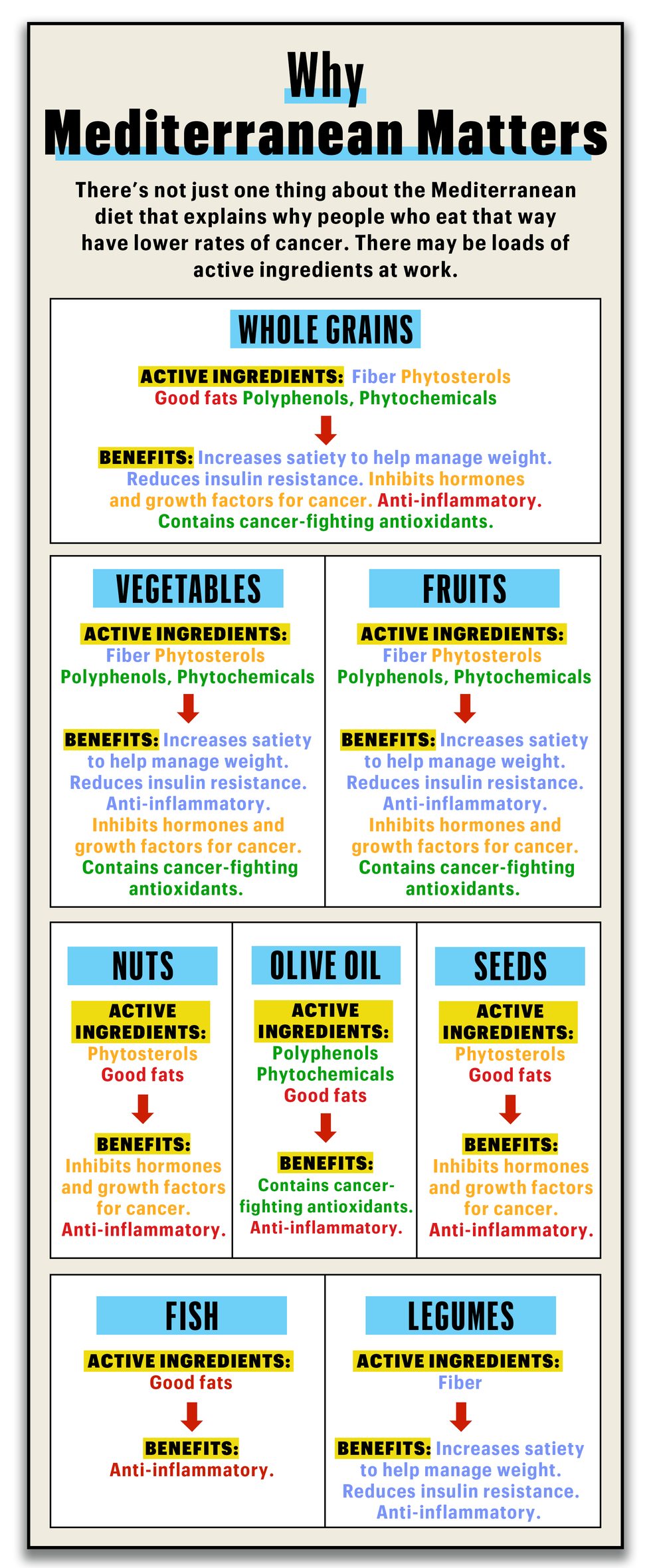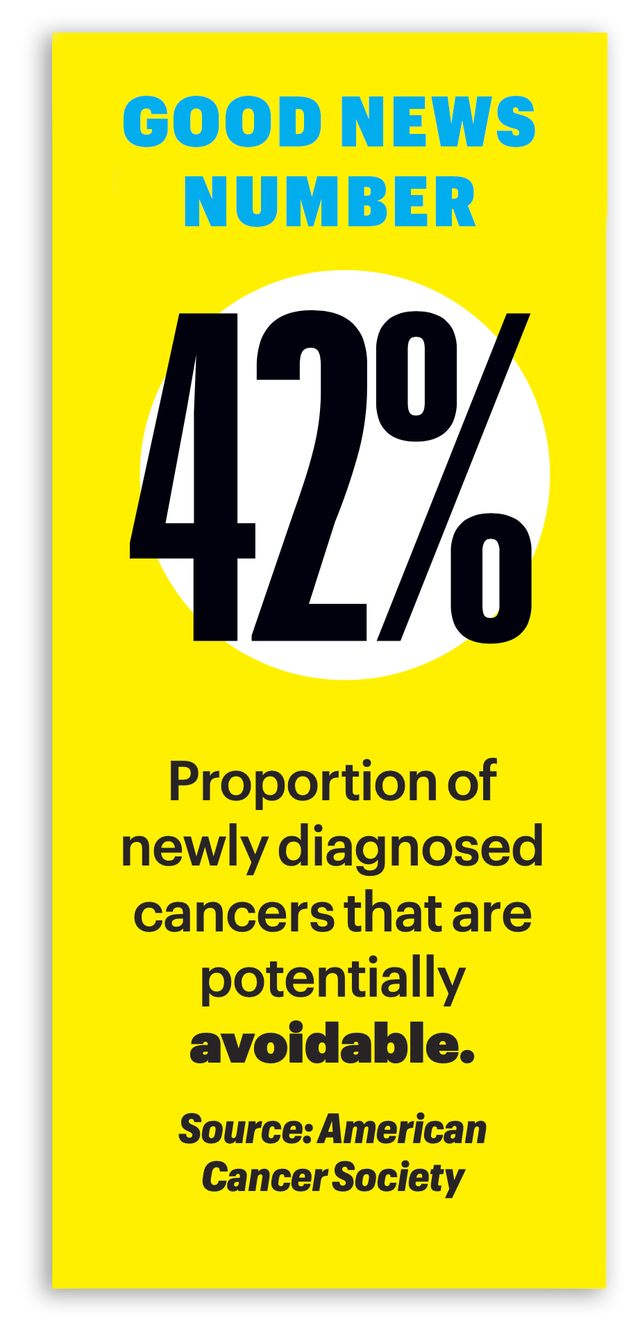Introducing The Optimist’s Guide to Cancer, where we outline actionable, strategic steps for cancer prevention and survival. To read the rest of the stories, click here.
SOMEDAY THERE MAY be drugs that protect you from all types of cancer. There’s a vaccine already—the HPV vaccine—that does just that for certain types. And labs all over the world are trying to read your body’s signals and find biomarkers in your blood that ID who’s at increased risk for what cancer so that they can target exactly what you need to do to prevent it. You can talk molecular targeting and mRNA therapy all you want, but when you ask researchers about the most successful way to prevent cancer right now, they’ll tell you the answer is in your hands. Forty-two percent of new cancers may be avoided if you make lifestyle changes that reduce your risk. These tweaks make a greater difference than you might think. These are 6 ways to reduce your risk.
YES, WE’RE GOING to mention weight here. That’s because researchers are now discovering a major link between obesity and cancer. How much obesity affects the risk of cancer kind of depends on the type, but the National Cancer Institute says that excess weight may lead to as many as 48 percent of liver and gallbladder cancers and about 33 percent of esophageal cancers in men. Excess bodyweight may also have a role in (deep breath here) multiple myeloma, breast, meningioma, kidney, upper stomach, pancreas, thyroid, and colon cancers.
Fat tissue doesn’t just sit there. It produces hormones that can encourage cells to multiply and blunts those that rein in proliferation—dangerous with cancer. People with obesity also often have higher levels of insulin—a state that increases your risk of certain types of cancer. Add to all this the fact that the chronic inflammation that comes with obesity can lead to DNA damage and you have yourself a potential firestorm. Luckily, you can take charge.
Assess Your Waist-to-Hip Ratio
Use this method to see if your body fat is putting you at risk. It’s better than BMI and way better than your scale readout.
Step 1: Get a tape measure and loop it around your waist at the smallest point. Record the number.
Step 2: Measure the widest part of your hips. Record that, too.
Step 3: Now divide the number you got for your waist by the number you got for your hips.
Results for men:
1.0 or over = elevated risk*
0.99 or below = normal risk
*There’s no single right to-do:
Maintaining a healthy weight involves using the exercise, diet, and mental-
health practices that work for you. Just get enough activity: That’s 150 to 300 minutes of moderate-intensity exercise, 75 to 100 minutes of vigorous-intensity exercise, or a combination of both, as well as two days of muscle-strengthening activity, each week.
Check for Insulin Resistance
Extra pounds often bring insulin resistance, which ups cancer risk. Check yours with a blood glucose test or an A1C test (done with a blood draw).
THERE’S GROWING EVIDENCE that following the Mediterranean diet may reduce your risk of various cancers, like lung, colorectal, and prostate. In fact, a new study in Cancer found that the eating plan, which emphasizes fruits and vegetables, whole grains, legumes, fish, and olive oil while limiting meat and dairy, may even slow the progression of prostate cancer. It may be related to chronic inflammation, which can feed the growth of cancerous cells, says Justin R. Gregg, M.D., an assistant professor of urology at University of Texas MD Anderson Cancer Center in Houston and lead author of the Cancer study. If you’re not already eating this way, Dr. Gregg suggests making changes gradually instead of all at once. So try upping your fish intake by one meal a week as a start.
NO SURPRISE BUT still essential. A full 20 percent of all cancers—one in five—are caused by smoking. (Lung cancer is still the cancer that kills the most men.) Vaping only became commercially available in the U.S. in 2006, so there’s not a lot of long-term cancer data, but no doctor will tell you that vaping is good for you. It’s not easy to quit, but cessation programs—not cold turkey—are the smarter way to go.
MORE THAN FIVE drinks a day or 15 a week can raise a man’s risk of colorectal, breast, esophageal, liver, stomach, mouth, and throat cancers by up to 500 percent. So however much you drink, the American Institute of Cancer Research suggests drinking less. The booming nonalcoholic–beer market totally has your back: Try Asahi Dry Zero, Lagunitas IPNA, or anything from Athletic Brewing Co.
DESPITE A GROWING awareness of carcinogens in personal-care products, you need a chemistry degree to understand the labels. The Environmental Working Group can help. Its search-friendly database (ewg.org/skindeep) contains nearly 90,000 safe personal-care products. Or look for the EWG Verified label, which means the product is free of any chemicals flagged by the EWG as unsafe.
SOME HOUSEHOLD CLEANERS contain carcinogens. A recent study done by University of California researchers even showed potentially hazardous volatile and semi-volatile organic compounds in cleaner–sounding “green” products. (Note: There’s no regulation as to what makes a product “green.”) Opt for EPA Safer Choice certified products. Find them at epa.gov/saferchoice.
This story appeared in the May/June 2023 issue of Men’s Health.











Comments are closed.